
* After decades of disappointing experiments, during World War II the helicopter became a practical flying machine, though it wouldn't be seriously used in operations during that conflict. However, in the postwar period, helicopters quickly went into widespread use. One of the pioneers was the "Bell Model 47", which proved itself in commercial and military roles -- in particular, establishing medical air evacuation ("medevac") as a standard practice during the war in Korea. This document provides a history and description of the Bell 47, as well as Bell's other piston-powered helicopters. A list of illustration credits is included at the end.
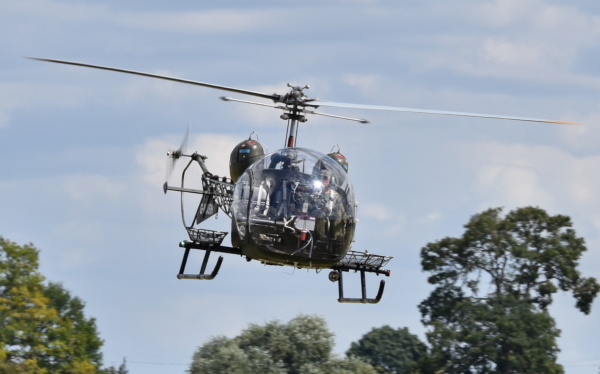
* Arthur Young was an American inventor from a wealthy family, who became interested in helicopters in 1928, leading him to development of a remote-control helicopter model, which he flew in 1941. At a conference of helicopter designers, Young presented a home movie of his model in flight; helicopter pioneer Igor Sikorsky was highly impressed, giving his congratulations to Young.
In September 1941, Young presented his ideas to Bell Aircraft in Buffalo, New York. Young had developed an innovative two-blade rotor system scheme that was much simpler than the rotor systems of other contemporary helicopters. Instead of balancing the rotor blades as they rotated in flight with an elaborate scheme of flapping and drag hinges, the entire rotor plane was tilted, with the tilt angle maintained by a stabilizer bar, or "fly bar", attached at a 90-degree angle to the blades. Young's scheme simplified the flight controls, while reducing the weight and maintenance requirements for the rotor system.
The company's boss, Larry Bell, was suitably impressed, and funded the construction of two demonstration helicopters -- Young insisted on two, lest the crash of a single prototype derail the program. Development work began on 1 November 1941, with Young and his apprentice, Bartram Kelley, moving their work to Gardenville, outside Buffalo, in June 1942.
Bell was swamped with war production at the time, with Young's effort surviving only on such resources as he was able to beg, borrow, or steal -- but he was determined, and pushed forward. The initial demonstrator, designated the "Model 30 Ship 1" and named "Genevieve", performed its first tethered flight on 18 December 1942. It was powered by a 120-kW (160-HP) Franklin engine, and had a rotor diameter of 10 meters (33 feet). The rotors were made of spruce, with a metal leading edge and balsa on the trailing edge. By June 1943, the initial Model 30 was flying at over 113 KPH (70 MPH).
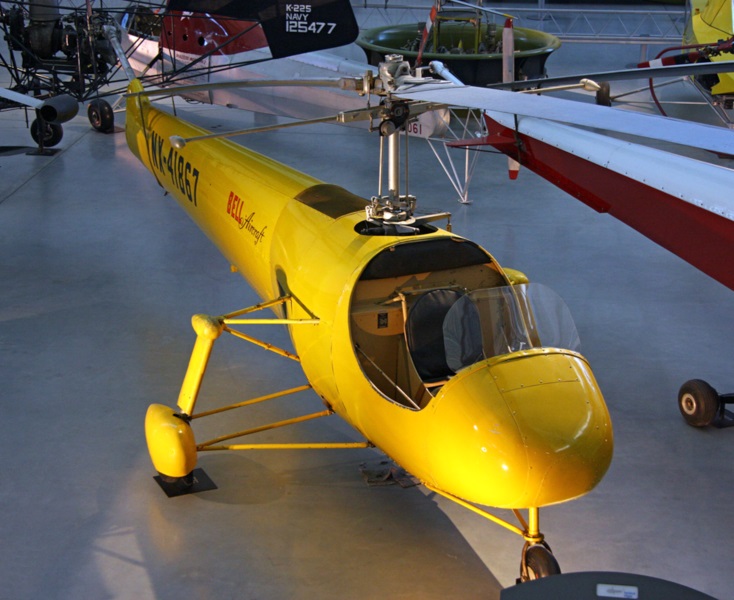
Two more prototypes were built, "Ship 2" having twin seats and an enclosed cabin; "Ship 3" with three seats and nothing that resembled a fuselage. Ship 3 flew the best -- though a trip on it was not for the timid, Young describing it as "like sitting in a chair and flying through space." Anything that was dropped by pilot or passengers disappeared, and company officials who took rides in it found it thoroughly frightening. Young also built a prototype of a coaxial-rotor helicopter, but it was damaged during development, with Larry Bell then having it scrapped without Young's consent.
BACK_TO_TOP* Development was interrupted when Bell moved its facilities to Niagara Falls, New York, in June 1945. However, work quickly resumed, with the first flight of the "Bell Model 47", on 8 December 1945. It was derived from the Ship 3 prototype, featuring a two-blade wooden rotor, open airframe, an open cockpit, and four-wheel landing gear. The open airframe reduced weight; the bubble canopy was innovative, nobody having thought to build such a large plexiglas structure before. The Model 47 obtained FAA certification on 8 March 1946, being the very first helicopter to be granted a civil certification.
The Model 47 proved to be one of the most popular helicopters ever built, being produced in a bewildering number of variants and sub-variants. Oddly, it doesn't appear to have ever been given any particular nickname -- unlike its successor, the famed UH-1 "Huey" helicopter.
* The initial production version, the "Model 47A", was a two-seat helicopter with an enclosed airframe, four-wheel undercarriage, and a 130-kW (175-HP) Franklin O-335-1 engine. The US Army bought 18 Bell 47As, for evaluation, 13 of them being given the designation of "YR-13", with three kitted up for Arctic trials under the designation of "YR-13A". Some sources hint that the YR-13s were later given the updated designation of "YH-13". The US Navy obtained another ten for evaluation, under the designation of "HTL-1". The Navy would always be a minority user of the Model 47, using the type largely for training, instead of utility use.
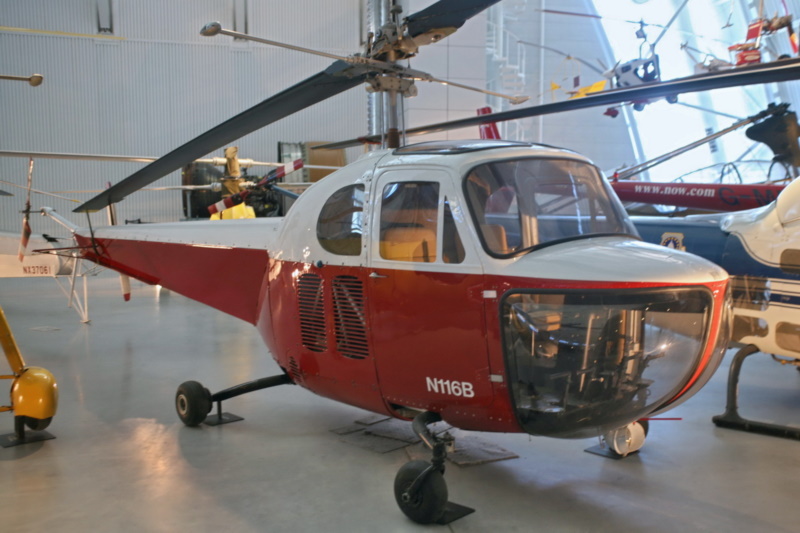
The Bell 47A was followed by the "Model 47B-1", with a fully-enclosed fuselage and an automobile-style cockpit, powered by a 133-kW (178-HP) Franklin 6V4-178-B3 engine. Young didn't like the idea, and it didn't sell; Bell had been banking on a boom market for private helicopters in the postwar period, but it didn't materialize. However, there was a commercial market, leading to the "Model 47B-2" and "Model 47B-3" -- optimized for agricultural use, the B-2 being for crop spraying, the other for crop dusting. They were identical except for working kit; they reverted to the bubble cockpit and open airframe, and were powered by a 133-kW (178-HP) Franklin 6V4-178-B3 engine. Sales proved lively.
An improved commercial version, the Bell "Model 47D" -- there was never a model 47C -- received FAA certification in late 1947. The Model 47D featured an improved two-piece bubble canopy with a removeable top and an enclosed airframe using fabric covering. The fabric covering was at the insistence of Larry Bell, who was basically a salesman and felt an open airframe would make the machine look unfinished. Young didn't like the covering, since all it did was add weight and make the machine more sensitive to crosswinds.

The Model 47D was powered by a 133-kW (178-HP) Franklin 6V4-178-B32 engine. It was available in a float version, the "Model 47D-S". However, rival helicopter designer Stanley Hiller had introduced his "Model 360" helicopter, in a class with the Model 47, but with three seats and other improvements. Bell had to respond, coming up with a major re-design, the "Model 47D-1", also with three seats. The third seat was accommodated by reducing weight -- reverting to the open frame, adopting skid landing gear, and using a single-piece bubble cockpit -- as well as by uprating to a Franklin O-335-5 engine, providing 150 kW (200 HP).
The US Army bought 65 Model 47D-1s with dual controls under the designation "H-13B" -- calling it the "Sioux", the Army liking names of American native tribes for their flying machines -- while the US Navy bought 12 as the "HTL-2". The Army converted 16 of their H-13Bs to the "H-13C" air ambulance configuration, with an external stretcher on each side of the cabin.
* In the late 1940s, Bell was suffering from postwar cutbacks in defense spending. By the end of 1948, Bell had shrunk to 4% of its wartime peak of employment, with a staff of only 1,861. Arthur Young was gone by this time, having retired in that year, and Bart Kelley became head of helicopter engineering in his place. Kelley would become a senior vice president of Bell in 1971.
Bell continued to work on refining the Model 47; when war broke out in Korean in June 1950, it would save the company's fortunes -- becoming a symbol of the war even decades later, being prominently featured in the popular American M.A.S.H. (Mobile Army Surgical Hospital) TV show of the 1970s. Use of helicopters to haul wounded troops to safety would cut combat fatalities in half, relative to World War II. Larry Bell had acquired a stockpile of hundreds of Franklin engines in anticipation of the postwar civil helicopter boom that didn't actually happen; they came in very useful for ensuring rapid delivery of military machines, Bell called the purchase of the engines "the best mistake I ever made."
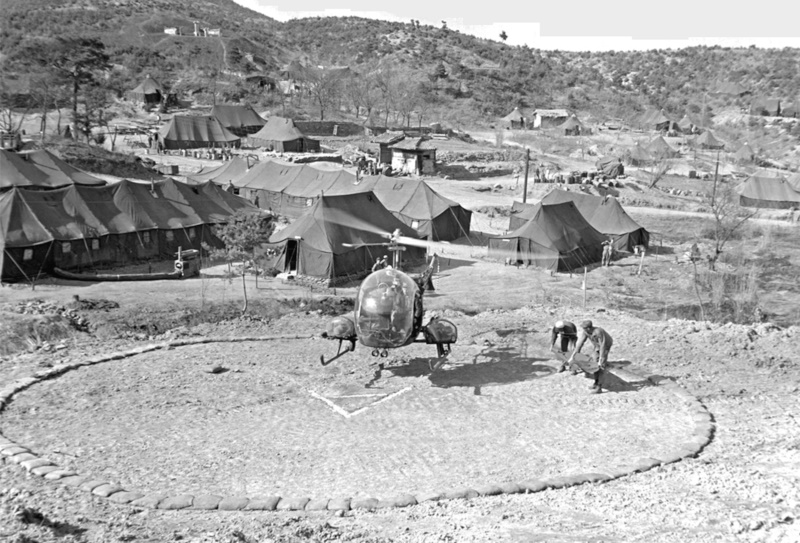
The Army obtained 87 "H-13Ds", which were effectively new-build H-13Cs with litter carriers. The Navy bought 46 with dual controls as the "HTL-4" -- which was redesignated "TH-13L", the "T" standing for "training", when the Pentagon adopted a multi-service designation scheme in 1962. The Army also requested a version with dual controls and a third seat, obtaining 490 of this variant as the "H-13E" ("OH-13E" from 1962, the "O" indicating "observation").
The Navy bought 36 Bell 47D-1s as the "HTL-5" (redesignated "TH-13M" in 1962). One H-13E was modified to evaluate a Continental XT51 (Artouste) turboshaft engine, being designated the "XH-13F"; it didn't go into production, and in fact no production Bell 47 would have a turboshaft engine.
* Bell moved its helicopter operation to Fort Worth, Texas, in 1951, as the Bell Helicopter Division. Model 47s were still rolling off the production lines in volume, with the 1,000th delivered in April 1953.
The US Navy obtained nine "HTL-3" machines, which was a two-seat variant with quadricycle landing gear, enclosed tailboom, bubble canopy, and a 150-kW (200-HP) Franklin 6V4-200-C32 engine. Bell called it the "Model 47E", though none were sold to civilian users. However, three were provided to Brazil under the US Military Assistance Program (MAP).
There was no production Model 47F machine. In May 1953, Bell introduced the definitive "Model 47G", a three-seat derivative of the Model 47D with a 150-kW (200-HP) Franklin 6V4-200-C32AB engine, a modified tail arrangement, distinctive saddle fuel tanks (replacing a fuel tank behind the rotor), and an improved rotor system.

It was followed by refined G-series variants:
The Army bought 265 "H-13G" (later "OH-13G") machines similar to the Bell 47G-2, the main change being stretcher carriers, while the Navy bought 48 machines in the same general configuration, but with dual controls for flight training, as the "HTL-6" (later "TH-13M"). The Army then went on to obtain 468 "H-13H" machines -- the H-13H being an H-13G with an Avco Lycoming VO-435-23 engine, providing 185 kW (250 HP), plus refined skid landing gear.
___________________________________________________________________
BELL MODEL 47G-3B:
___________________________________________________________________
rotor width:
11.32 meters (37 feet 2 inches)
fuselage length:
9.63 meters (31 feet 7 inches)
height:
2.83 meters (9 feet 3 inches)
empty weight:
858 kilograms (1,893 pounds)
max loaded weight:
1,340 kilograms (2,950 pounds)
maximum speed:
170 KPH (105 MPH / 90 KT)
range:
395 kilometers (245 miles / 215 NMI)
___________________________________________________________________
In 1952, Agusta of Italy obtained a manufacturing license to build the Bell 47, producing the first "Agusta-Bell Model 47G" in 1954. In 1955, Kawasaki of Japan obtain a manufacturing license as well; both firms developed their own unique variants of the Model 47.
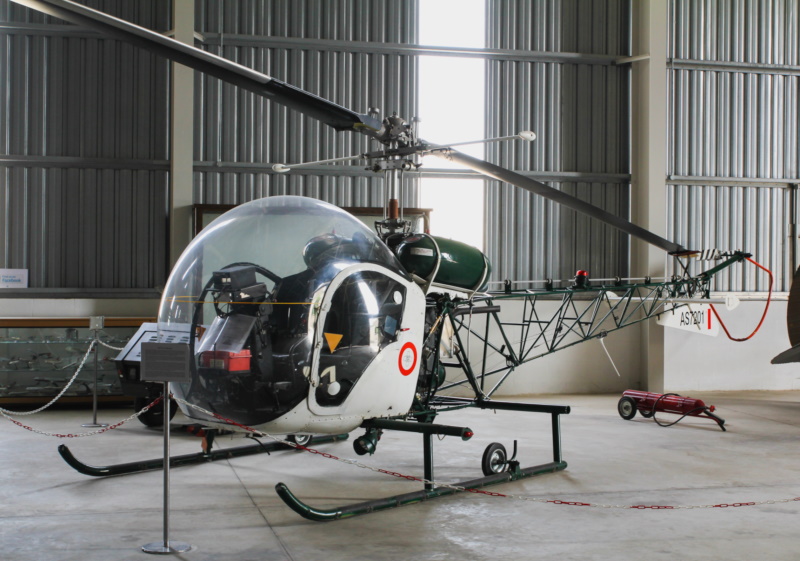
One of the biggest Agusta customers was the British Army, which bought 300 "Model 47G-3B-1S" machines as the "AH.1 Sioux". 50 of this batch were built by Agusta, while the rest were assembled by Westland of Britain from Agusta-supplied kits.
BACK_TO_TOP* The redesigned "Model 47H-1" was effectively a Model 47G, with an enclosed automobile-style fuselage, a wider cockpit with soundproofing, seating for three, and a baggage compartment; it was intended as an executive transport. It wasn't successful, but it led to the "Model 47J", featuring an enclosed fuselage with the dynamic system of the Model 47G, the powerplant being a Lycoming VO-435-21 engine with 165 kW (240 HP). It had seats for four, with a pilot up front, and a bench seat for three in the back.

The "Model 47J-1" simply featured a slightly improved VO-435A engine, while the "Model 47J-2 Ranger" featured a more powerful Lycoming VO-540-B1B engine providing 180 kW (240 HP); metal rotor blades; and power-boosted controls. It proved popular as an executive transport. Agusta also built a series of their own "AB-47J-2" and "AB-47J-3" variants, including machines that could carry a torpedo for anti-submarine warfare (ASW) operations.
The Air Force obtained two Bell 47Js as VIP transports, being the first helicopters to be dedicated to the presidential flight, giving them the designation of "UH-13J". The Navy bought 27 as the "HUL-1" (later "UH-13P"), and the Coast Guard obtained two as the "HUL-1G" (later "HH-13Q"); the Navy and the Coast Guard used them for rescue duties.

The Navy also bought 18 "Model 47K" trainers under the designation "HTL-7" ("TH-13N" from 1962). They were similar to the Model 47J, with a Lycoming 0-435-6 engine providing 180 kW (240 HP), but had two seats and dual controls.
Two "Model 47L" machines, also known as the "HUL-1M" (later "UH-13R"), were flown; they were Model 47Js fitted with the Allison YT63 turboshaft engine, providing 210 kW (285 HP), taking to the air in 1961. That was effectively the end of the line; the last Bell 47 off the Forth Worth production line, a 47G-3B2A, was rolled out on 14 February 1974, after production of 5,800 Model 47s of all types by all manufacturers.
Agusta production lingered to 1976, with the Italian firm producing over a thousand AB-47G and AB-47J machines. Kawasaki built 11 Model 47D, 228 Model 47G, and 211 "KH-4" machines -- the KH-4 being a Japanese-designed variant of the Model 47 with a stretched cockpit and accommodations for five. The Model 47 flew in dozens of countries and armed services. There has been a lively market for upgrades, for example a turboshaft powerplant, modernized avionics, and specialized mission kit, keeping the Model 47 in service in the 21st century.
BACK_TO_TOP* In the late 1940s and early 1950s, the Bell company also pursued a number of other piston-powered helicopters, none of which were successful.
While the Model 47 was being introduced, another Bell group was working in parallel on a luxury helicopter for the civilian market, the "Model 42". This was a five-seat rotorcraft with a streamlined automobile-type fuselage. The Model 42 weighed 2,310 kilograms (5,100 pounds), was powered by a Pratt & Whitney R-985 Wasp Junior 9-cylinder radial engine with 335 kW (450 HP), and had a scaled-up version of the rotor system of the Model 30.
Three prototypes were built -- but the design team was used to working on fixed-wing aircraft, had difficulties understanding how to design a rotorcraft, and took a dismissive attitude toward Arthur Young's team. The initial prototype was so bad that Larry Bell had to call in Young to fix it; it nearly killed Young, who found it dangerous to fly. After the tail of one of the prototypes broke off, the project was effectively abandoned. Although Model 42 prototypes were displayed to the public, there was no interest in buying the type.
However, the military expressed some interest in the Model 42, leading to the scaled-up "Model 48". The Army Air Force ordered three prototypes in 1946, with two prototypes in the five-seat "XR-12" (later "XH-12") configuration, with a Pratt & Whitney R-1340 Wasp radial engine with 400 kW (540 HP), and the third prototype in the ten-seat "XR-12B" (later "XH-12B") configuration with an R-1340-55 Wasp with 450 kW (600 HP). The prototypes led to an order for ten pre-production "YH-12s", which could accommodate a crew of two and eight passengers, or a pilot, attendant, and six stretchers. No full production order followed, the Army preferring the much superior Sikorsky S-55 / H-19.
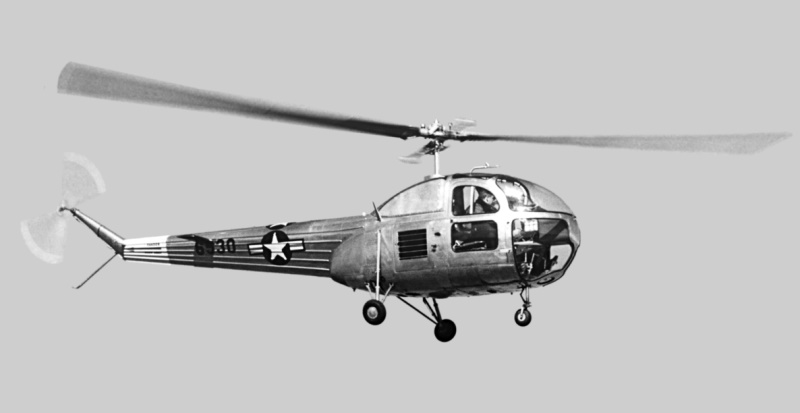
The Army also ordered three "Model 54" four-seat light observation and utility helicopters in late 1946, with the first flying as the "XH-15" in March 1948. It was a derivative of the Model 47, with the same dynamic system driven by a turbocharged 212-kW (285-HP) piston engine, but with a fully enclosed fuselage featuring tricycle landing gear. It suffered from serious development problems; the three prototypes were evaluated by the US Air Force, but no production order followed.
* In June 1950, Bell was selected to build the first ASW helicopter for the US Navy. The Bell "Model 61, or "HSL-1" in its naval designation, first flew on 4 March 1953.
The Model 61 was a large tandem-rotor helicopter weighing 11,800 kilograms (26,000 pounds), and was powered by a 1,415-kW (1,900-HP) Pratt & Whitney R-2800 radial engine. It could carry dipping sonar and other ASW sensors, depth charges, homing torpedoes, and Petrel ASW missiles. The Model 61 was one of the few tandem rotor helicopters built in the US that wasn't a Piasecki design. It used the two-blade Bell rotor scheme, with folding rotors for shipboard stowage, and had a crew of four, including pilot, copilot, and sonar operators.
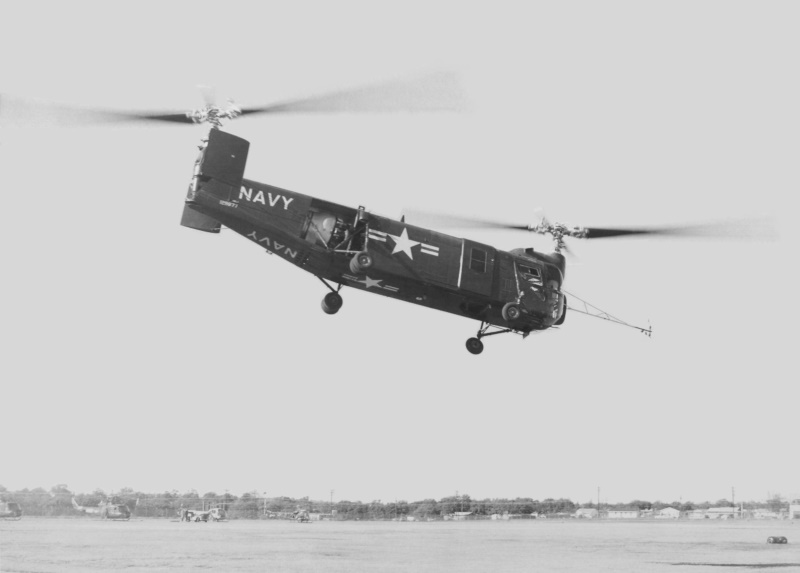
Three XHSL-1 prototypes were ordered. The type proved to be underpowered, with very high levels of interior noise, and performance was marginal at best. Only 50 were actually built; they saw very little service, most being mothballed immediately. That was just as well, since it was a remarkably ugly aircraft even by helicopter standards.
* The contrast between the success of the Model 47 and the dismal record of all other helicopters Bell developed in that time demonstrates the fact that in a corporate environment, the majority of projects are failures, but those that succeed can more than make up for the disappointments. In the late 1950s, Bell was able to follow up the success of the Model 47 with another winner, the UH-1 Huey, and ensure the continued survival of the company, but that is the subject of another document.
BACK_TO_TOP* As a footnote to the Model 47 story, Bell developed a demonstrator for a dedicated helicopter gunship, the "Model 207 Sioux Scout", essentially a Model 47J with a new forward fuselage featuring a tandem-seat cockpit, an undernose turret with twin M60 7.62-millimeter (0.30-caliber) machine guns, and stub wings that could carry unguided rockets. Initial flight was in July 1963. It was evaluated by the Army in 1964 to investigate the concept, suggesting what use might be made of a rotorcraft of its general type -- but it was never really intended to be a production machine, not being capable enough for operational service. It led to the Bell Model 209 / AH-1 Cobra gunship, which is still going strong in the 21st century.
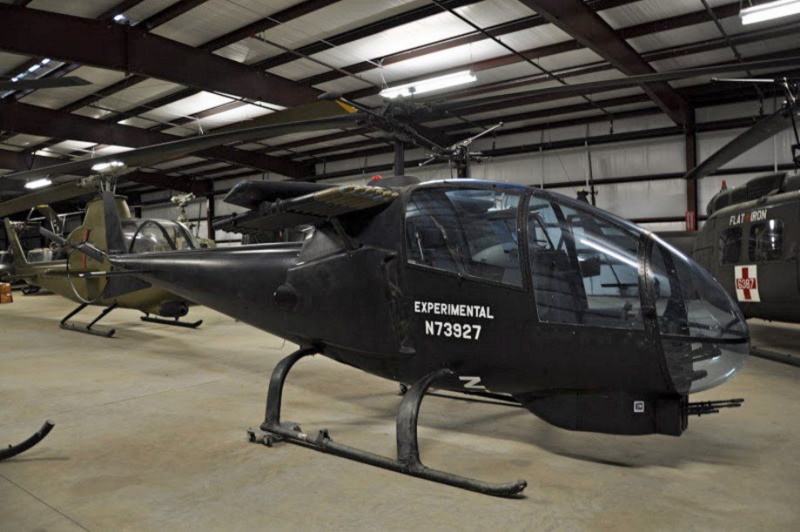
* As another footnote, a UK reader tipped me off to the fact that M.A.S.H. was not the first time the Bell 47 had a starring role in a TV show. In 1956, an episode of the long-running and popular I LOVE LUCY show -- of course, starring legendary comedienne Lucille Ball -- had an episode where she missed the departure of an ocean liner, and hitched a ride on a Bell 47G to the ship.
Desilu Studios, which made I LOVE LUCY, got the idea that helicopters might be a good basis for a TV show; after talking with Bell, Desilu came up with a show named WHIRLYBIRDS, about the adventures of a helicopter chartering company in the US West. It ran on syndication for three seasons, 1957 into 1960, with 111 half-hour black-&-white episodes in all. The primary players in the show were a Bell 47G and Bell 47J. The show has been forgotten; the Bell 47 hasn't.
* Sources include:
Most of the specifics were scavenged from online sources -- the Bell 47 is not well documented.
* Illustrations credits:
* Revision history:
v1.0.0 / 01 jan 16 v1.0.1 / 01 dec 18 / Review & polish. v1.2.0 / 01 nov 20 / Illustrations update. v1.2.1 / 01 mar 22 / Review & polish. v1.2.2 / 01 feb 24 / Review & polish.BACK_TO_TOP
